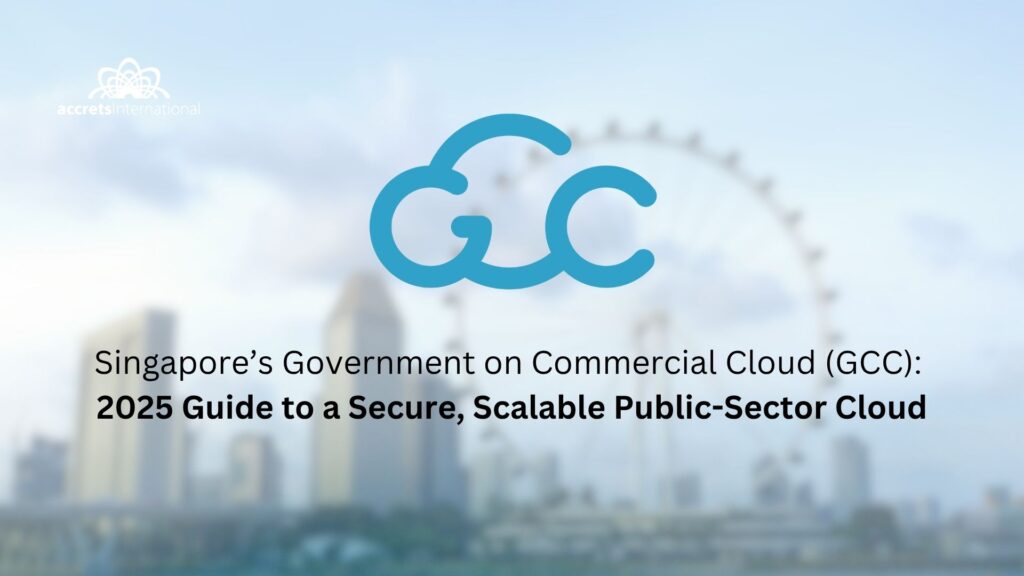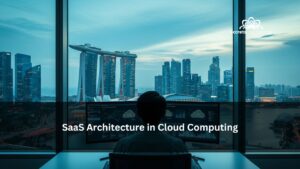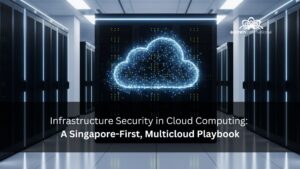Singapore’s Government on Commercial Cloud (GCC) represents the nation’s boldest cloud initiative to date. It enables agencies to deploy secure, compliant, and scalable workloads on AWS, Azure, and Google Cloud. Whether you’re an IT decision-maker or policy stakeholder, this article will explain everything you need to know about GCC, GCC+, and the ecosystem surrounding Singapore’s cloud-first journey. Let’s explore together and understand how it affects your strategy in 2025 and beyond.
Table of Contents
ToggleFrom Cloud-First to GCC+ : A 7-Year Timeline
| Year | Milestone | Why It Matters |
| 2018 | Cloud-First Policy announced in Budget 2018 | Set 70% migration target for eligible systems |
| 2019 | GCC 1.0 launched on AWS & Azure | Common security wrapper and onboarding toolkit |
| 2021 | GCC 2.0 released | Self-service portal, sustainability dashboard, Google Cloud added |
| 2023 | Target met, 70% of systems migrated | Proof that legacy-heavy agencies could modernise |
| 2024 | GCC+ pilot for Confidential workloads | Higher cryptographic controls, PDPA-aligned data residency |
| 2025 | 3,800 systems onboarded, 99.5% uptime | Focus shifts to AI sandboxes and carbon-aware scheduling |
GCC matured in lock-step with agency needs, moving from basic IaaS enablement to a full secure cloud operating model in under a decade.
What Is GCC and How Does It Differ From GCC+?
GCC is a centrally-governed framework, operated by GovTech, that wraps the big three hyperscalers (AWS, Microsoft Azure, Google Cloud) in a layer of automated guardrails. These include network segmentation, hardened AMIs, CIS-compliant baselines, and continuous compliance monitoring. Agencies can spin up resources in minutes without re-engineering security every time.
GCC+ extends that model to workloads carrying Confidential data classifications. These include law-enforcement evidence management or health-records analytics. It introduces enhanced encryption-at-rest, stricter key-management segregation, and sovereign-cloud residency within Singapore-only availability zones.
| Tier | Data Sensitivity | Typical Use-Cases |
| GCC | Restricted and below | e-Services portals, HR apps, geospatial APIs |
| GCC+ | Confidential | Case-management, biometrics analytics, financial-regtech workloads |
Key Compliance & Governance Pillars
IM8 & PDPA Alignment
All GCC blueprints map directly to the Infocomm Media Development Authority’s IM8 clauses 10.5 to 10.11 on data residency, as well as the Personal Data Protection Act (PDPA). Encryption keys stay within Singapore-housed HSM clusters, ensuring lawful cross-border transfers are tracked.
CSA Cloud Security Guidance v4
The Cyber Security Agency of Singapore’s latest guidance codifies zero-trust network access, continuous monitoring, and robust incident response. GCC’s shared services including central SIEM and privileged-access brokering are pre-approved patterns, accelerating audits.
ISO 27001 & MTCS Level 3 Mapping
Whether you pursue ISO certification or the Multi-Tier Cloud Security (MTCS) Level 3 mark, GCC artefacts such as policies, risk registers, and evidence packs cover over 80% of required controls out of the box, slashing audit prep time.
Expert tip: Agencies often pair GCC controls with a managed cloud hosting approach to free internal teams from daily patching. That’s exactly why organisations choose managed cloud hosting, as we explained in a recent Accrets article.
Under the Hood: GCC Architecture for CIOs & Developers
Shared VPC Model & Zero-Trust Controls
Each agency receives a logically isolated shared VPC. All north-south traffic tunnels through a central inspection zone using layer-7 firewalls and DLP engines. Role-based access cascades from GovTech’s IDP, enforcing MFA and device-posture checks.
Wrapper Services for AWS/Azure/GCP
- Secure Landing Zone Accelerator: Terraform modules for network, IAM, logging
- Container Guard: Admission controller that blocks images without signed SBOMs
- Secrets Factory: Hosted Vault cluster synchronised with KMS back-ends
Developers still enjoy native cloud APIs, but every pipeline step runs inside a hardened baseline. That aligns seamlessly with the core DevOps benefits for cloud we dissected earlier.
Business Benefits Backed by Data
Cost Optimisation & Sustainability Dashboards
GovTech’s GCC Portal reveals live spend per workload and carbon-equivalent emissions. Forty pilot systems cut compute costs by 22% and slashed energy use by 18% after automated rightsizing.
99.5% Uptime & 3,800 Systems Migrated
Since 2019, GCC logged only two region-wide P1 incidents, maintaining 99.5% aggregate availability. This eclipses most on-premise records. If that reliability sparks thoughts of hybrid designs, see why private cloud remains a reliable back-end for certain workloads.
Field-Tested Use-Cases & Case Studies
Energy Market Authority: Smart-Meter Analytics on Azure
EMA ingested billions of IoT readings through Azure Event Hubs, secure-wrapped by GCC. Result: analytics lead time dropped from days to near-real-time, while compute cost per job fell 35%.
GoBusiness & MyCareersFuture Microservices
These citizen-facing portals shifted from monoliths to microservices, leveraging GCC’s container guardrail. Feature velocity jumped 60% while release rollbacks shrank to seconds.
Such agile, modular builds mirror the DevOps cloud advantages we broke down earlier.
Migration Checklist & Partner Ecosystem
Step-by-Step RFP Questions
- Which classification (Restricted vs Confidential) does your data hold?
- Do you need connectivity to SGWAN, internet or both?
- Is your workload cloud-native or “lift-and-shift”?
- What’s your required RPO/RTO?
- Do you need sandbox isolation for AI workloads?
Top SI Partners vs DIY
| SI Partner | Certifications | Notable Gov Projects | When to Choose |
| NCS | AWS Gov Competency, ISO 27001 | EMA migration | Large-scale lift-and-shift |
| Accenture | Azure Expert MSP, MTCS L3 | Smart Nation Sensor Platform | Multi-cloud hybridity |
| S&I | CISSP-led team | Municipal chatbots | Rapid PaaS builds |
Before finalising your tender, compare the best cloud infrastructure providers in Singapore side-by-side.
Future Outlook: AI-Ready Government Cloud & Green Computing
Generative-AI Sandboxes on GCC 2.1
A coming release will offer GPU “walled gardens” where agencies fine-tune LLMs without leaking data. Expect MLflow pipelines tied into central Secrets Factory for model provenance.
Carbon-Aware Workload Scheduling
Inspired by research into green cloud computing, GCC’s optimiser will soon bias workloads toward times of lower grid-carbon intensity. This helps ministries hit public-sector sustainability targets.
Looking further, analysts project Singapore’s cloud spend to double by 2030. This reflects trends we outlined in the future of cloud computing.
Conclusion & Next Steps
Singapore’s GCC story shows that security and speed are not mutually exclusive. By standardising guardrails, sharing services, and nurturing a partner ecosystem, GovTech unlocked genuine agility for more than 80 agencies.
Ready to architect or optimise your agency’s GCC deployment?
Fill the form below to talk with an Accrets Cloud Expert and explore our on-premise private-cloud services for hybrid resilience.
Contact an Accrets expert for GCC Cloud Singapore → https://www.accrets.com/contact-us/
Dandy Pradana is an Digital Marketer and tech enthusiast focused on driving digital growth through smart infrastructure and automation. Aligned with Accrets’ mission, he bridges marketing strategy and cloud technology to help businesses scale securely and efficiently.




